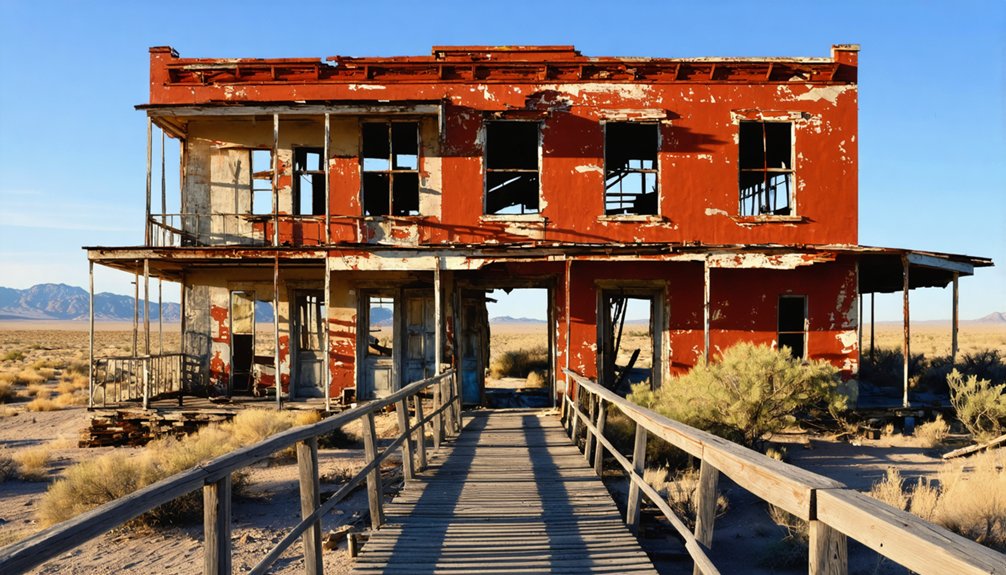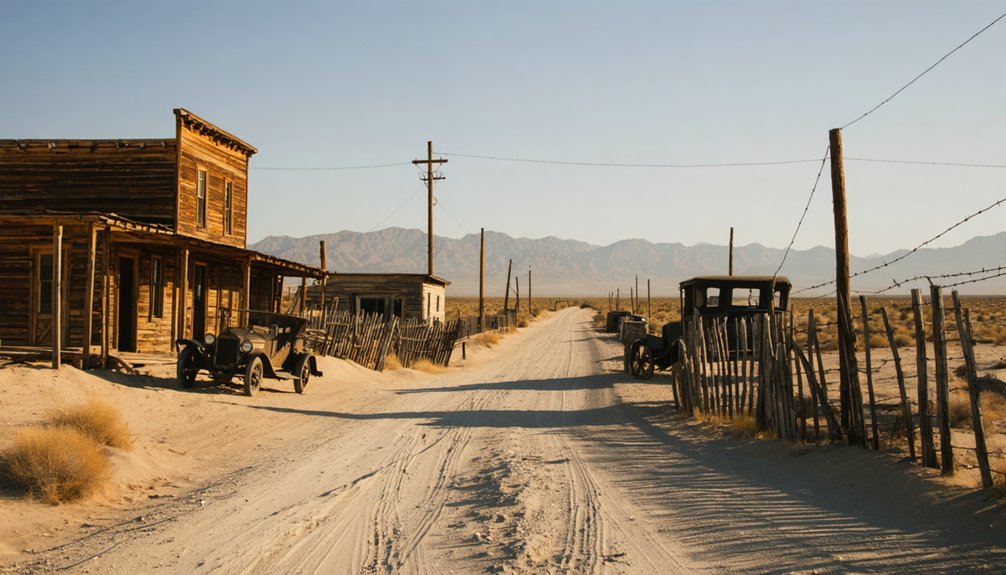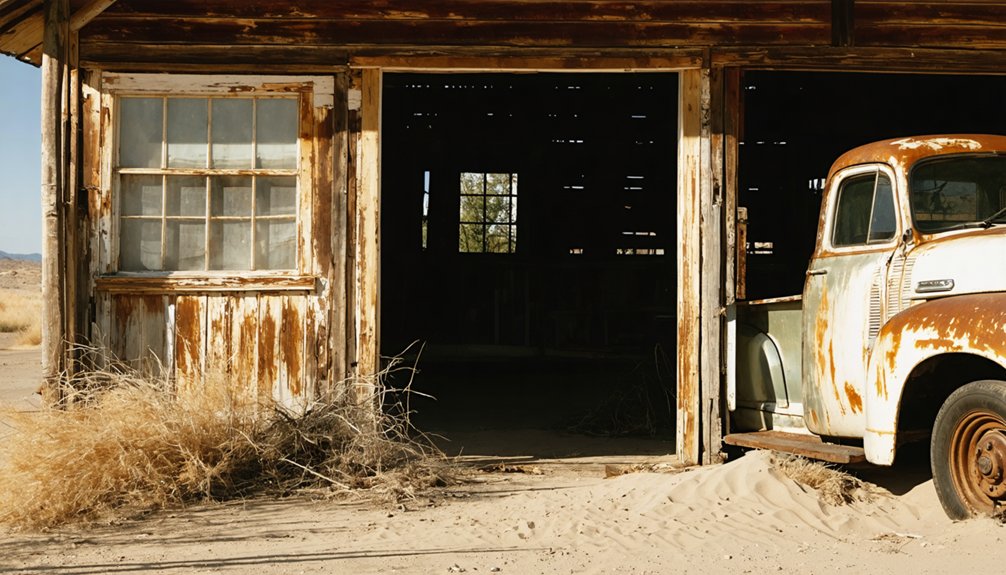Vernette is a hidden ghost town nestled in California’s northern Sierra Nevada Mountains within the Lost Sierra region. You’ll find remnants of its gold rush heritage dating back to 1848, when President Polk’s announcement triggered a population boom. The site features weathered mining cabins, abandoned shaft systems, and artifacts from a once-thriving community. Its decline came through exhausted mineral deposits, fires, and economic challenges. This vanishing piece of California’s mining history offers compelling photographic opportunities for those willing to explore.
Key Takeaways
- Vernette is a hidden ghost town located in the rugged northern Sierra Nevada Mountains within California’s Lost Sierra region.
- The town thrived during California’s gold rush era but declined due to mineral depletion, economic downturns, and devastating fires.
- Architectural remains include weathered mining cabins and elaborate shaft systems reaching depths of 900 feet.
- The population consisted primarily of miners, railroad workers, and diverse laborers including Irish, Chinese, and Mexican groups.
- Vernette offers compelling photographic opportunities with unique lighting conditions and historical structures against dramatic mountain backdrops.
The Lost Sierra: Finding Vernette in the Mountains
Nestled within the rugged northern Sierra Nevada Mountains lies Vernette, one of California’s hidden ghost towns in the region known as the Lost Sierra.
Forgotten by time, Vernette waits silently among pine-clad peaks in California’s mysterious Lost Sierra.
If you’re seeking a journey into mining heritage that few travelers experience, you’ll need to navigate challenging terrain to reach this remote settlement.
The Lost Sierra earned its name from its isolation and untamed character, hosting numerous mining camps like Vernette that thrived briefly during gold rush peaks.
You’ll find Vernette situated along historic mining routes that once facilitated ore transportation and supplies.
Dense forests have reclaimed much of the landscape, obscuring the foundations of what was once a bustling community. Early mining towns like Vernette were often constructed without foundations, leading to their rapid deterioration after abandonment.
The surrounding environment showcases gold-bearing quartz veins that initially attracted prospectors to this mountainous wilderness, creating a fleeting moment of prosperity before abandonment. Like many California ghost towns, Vernette’s eventual decline came as resources dwindled and miners moved to more promising locations.
Gold Rush Origins: Birth of a Boom Town
While the 1848 discovery of gold at Sutter’s Mill sparked California’s famous Gold Rush, it wasn’t until President Polk’s December 5th address to Congress that Vernette’s story truly began.
As news spread through Brannan’s famous gold proclamation and newspaper reports, Vernette emerged among the destinations for “forty-niners” seeking fortune.
You’d have witnessed ships abandoned in San Francisco harbor as crews deserted for the goldfields, with many heading toward this promising boom town. The city saw explosive growth similar to San Francisco, which transformed from a small village of 400 to a major port city with 150,000 inhabitants by 1852.
Early prospectors in Vernette employed placer mining techniques, using rockers introduced by experienced miners like Humphrey.
The settlement grew rapidly as merchants, following Brannan’s example, established stores stocked with mining equipment to serve the influx of approximately 300,000 fortune seekers.
Women were scarce in Vernette, as they represented only 700 individuals among the 40,000 people arriving by ship in 1849.
Vernette became part of the “California Dream”—a place where determined individuals sought freedom and fast success.
Daily Life in 1850s Vernette
If you’d visited Vernette in the 1850s, you’d have found miners crowded into hastily constructed wooden cabins and communal boardinghouses where multiple families often shared tight living quarters with minimal comforts.
After exhausting days of physical labor, residents would gather for simple entertainment, sharing stories and news while relaxing in these communal spaces. The population was predominantly male, with women representing less than 40% of residents, similar to the gender imbalance seen in other California settlements during this period.
Music, storytelling, and informal gatherings formed the backbone of social life, creating strong community bonds despite the harsh conditions and transient nature of the mining population. Many residents experienced gold fever initially but faced disappointment as accessible gold deposits quickly became exhausted.
Rough Mining Quarters
After gold was discovered in the region, Vernette’s mining quarters quickly developed into a stark reflection of frontier hardship and practicality.
You’d find yourself living in hastily constructed 10 by 12-foot cabins built from local timber and canvas, with minimal protection against the elements.
Mining hardships extended beyond the work itself into daily existence. You’d sleep on crude bunks or floor blankets, often sharing your cramped space with multiple other miners. Your roof—typically sod or canvas—would leak during precipitation.
Many endured communal living arrangements out of necessity, cooking over open fires in shared areas while battling the lack of sanitation. Those arriving earliest might’ve resided in simple tents or dugouts until more permanent structures could be established. The atmosphere was similar to established mining towns like Bodie, which eventually boasted 65 saloons along its Main Street during peak population. The winter conditions were especially brutal as bitter winds dropped temperatures well below freezing.
Personal possessions remained few, limited to essential tools and clothing.
Community Entertainment Options
Despite the challenging living conditions, Vernette offered a surprising array of entertainment options that served as essential escapes from the harsh realities of mining life.
You’d find multiple saloons functioning as primary entertainment venues, featuring card games, live music, and occasionally staged performances. The general store doubled as a communal gathering spot for news exchange. The popularity of these social venues reflected the boom and bust cycles that characterized California’s mining towns throughout history.
When seeking physical recreation, you could join horseback riding excursions, hunting parties, or fishing trips along nearby streams. During community gatherings, you might participate in seasonal celebrations like Independence Day festivals or attend traveling shows featuring musicians and theatrical troupes. A common saying among residents heading to more lawless entertainment districts was “Goodbye God, I’m going to Bodie.”
Churches hosted not only religious services but social events and lectures. For quieter evenings, domestic entertainment included storytelling circles, quilting bees, and informal music sessions featuring fiddles and other portable instruments.
Mining Techniques and Operations
The mining techniques employed in Vernette and its neighboring California ghost towns evolved considerably throughout the late 1800s and early 1900s.
The rugged landscape of Vernette saw mining methods transform from primitive to industrial as California’s mineral boom matured.
You’ll find evidence of both placer and lode gold mining operations that formed the backbone of the region’s economy. Hard-rock mining dominated the landscape, particularly for extracting silver-lead ores through elaborate shaft and tunnel systems reaching depths of 900 feet.
Ore extraction varied widely, from steam-powered 10-stamp mills at Silverado Mine to handmade dry washers used by prospectors like Reche on Goat Mountain.
The Montana Mine near Vernette yielded impressively rich silver-lead ore, sometimes assaying at 80-90 ounces per ton.
Before mechanization, mules and manual labor transported ore from remote mining sites to processing facilities, highlighting the rugged determination of those who sought fortune in California’s mineral-rich hills.
Architectural Remains and Historic Structures

You’ll find weathered mining cabins dotting the Vernette landscape, including the preserved 1958 post office cabin that now serves as a California Historical Resource.
Gold processing structures, unlike the elaborate facilities of larger mining towns, remain as simple remnants showcasing the practical nature of Vernette’s operations.
The crumbling town infrastructure, while modest compared to company towns like Eagle Mountain, offers researchers valuable insights into rural postal services and the community’s historical significance to the Morongo Basin region.
Weathered Mining Cabins
Nestled within the rugged terrain of the Morongo Basin, Vernette’s weathered mining cabins stand as resilient monuments to California’s frontier history. Among these weathered structures, the Vernette Cabin exemplifies the area’s mining heritage through its modest yet functional 400-square-foot design, constructed in 1958 under the Homestead Act.
- Built with simple wood-frame construction reflecting mid-20th century rural architecture
- Divided strategically into two sections: postal workspace and public area
- Transformed into a rural contract postal station in May 1962
- Served as both essential communication hub and private residence
- Now preserved by the Morongo Basin Historical Society as a reflection of frontier life
You’ll find these cabins accessible via unpaved roads, emphasizing their isolated nature while showcasing how residents adapted to life in this remote desert community.
Gold Processing Structures
Scattered throughout Vernette’s arid landscape, five distinct gold processing structures reveal the technological evolution of mineral extraction methods from 1860 to 1942.
These weathered remnants stand as silent witnesses to California’s golden era, each representing advancements in mining technology that transformed raw ore into valuable commodity.
You’ll find the massive stone foundation of the stamp mill where crushing mechanisms once thundered day and night, alongside the mercury amalgamation facility with its distinctive circular retaining walls.
The cyanide processing plant‘s concrete vats remain remarkably intact, while the assay office’s brick chimney still points skyward.
Most impressive is the aerial tramway terminal—its wooden superstructure long gone but steel cables still embedded in ghost town architecture, demonstrating how ore moved efficiently from mineshaft to processing site.
Crumbling Town Infrastructure
Nearly a dozen structures remain in Vernette’s town center, providing a remarkably complete architectural timeline of a frontier mining settlement.
These crumbling structures stand as silent witnesses to California’s gold rush era, with weathered wooden facades and stone foundations that have withstood over a century of harsh desert conditions.
The abandoned roads, once bustling with miners and merchants, now lead visitors through a town frozen in time.
- The saloon’s partially collapsed roof reveals original hand-hewn beams and joinery techniques from the 1860s
- Remnants of the assay office feature a rare iron vault door manufactured in San Francisco
- The mercantile building’s stone foundation incorporates unique local limestone quarried by Chinese laborers
- Several residential cabins display evolving construction methods spanning 1850-1890
- The schoolhouse remains remarkably intact with original slate chalkboards and carved student desks
Notable Characters and Families of Vernette

Unlike many historic Western settlements with colorful characters and founding families, Vernette’s social landscape was remarkably anonymous.
You’ll find no legendary sheriffs, wealthy mining magnates, or colorful madams in the town’s sparse historical record. The transient population consisted primarily of railroad workers and miners who rarely established permanent roots.
Southern Pacific employees formed Vernette’s backbone, including section hands and maintenance crews who lived in company housing.
Mining families dwelled in modest homes near operations like the Relief Mine. The few businesses—general stores, saloons, and boarding houses—catered to these workers, but their proprietors remain largely undocumented.
Census records reveal a diverse workforce of Irish, Chinese, and Mexican laborers, but no surnames recur prominently enough to identify foundational families in this working-class settlement.
The Slow Fade: Why Vernette Was Abandoned
While many ghost towns in California’s history disappeared dramatically through sudden catastrophes, Vernette’s demise followed a gradual pattern of economic attrition and population decline.
You’ll recognize familiar elements of boomtown collapse as mining operations became increasingly unprofitable, triggering a domino effect of closures and departures.
- Exhaustion of mineral deposits made continued extraction financially untenable
- National economic downturns, including the Panic of 1907, devastated remaining businesses
- Devastating fires destroyed key structures with no resources for rebuilding
- Geographic isolation and harsh terrain limited alternative economic opportunities
- Water scarcity prevented agricultural development as a replacement industry
This economic decline mirrors the fate of many resource-dependent settlements throughout California—once the original purpose vanished, little remained to sustain community life.
Visiting Today: How to Reach the Ghost Town

Tucked away in the rugged terrain of Elsmere Canyon in Los Angeles County, Vernette remains accessible to determined visitors willing to navigate its remote location.
You’ll find the ghost town via Elsmere Canyon Road off the 14 Freeway near Sierra Highway (34.4333° N, 118.2500° W). High-clearance vehicles are recommended for the unpaved access road.
The 1.5-mile trail begins at the marked trailhead where limited parking is available. As you follow the relatively flat path through the canyon floor, you’ll pass historical structure remnants.
Essential hiking tips: wear sturdy footwear, carry ample water, and check weather forecasts before visiting. The area has minimal cell reception and no facilities, so prepare accordingly.
Spring and fall offer the most comfortable hiking conditions to explore this historical site.
Preservation Efforts and Historical Significance
Preserving the historical legacy of Vernette stands as a critical endeavor for California’s cultural heritage institutions and local historians. This ghost town preservation initiative balances structural restoration with maintaining authentic aged character, ensuring that Vernette’s mining heritage remains accessible to future generations.
You’ll find various stakeholders involved, from government agencies to volunteer historical societies working to protect these fragile remnants.
- State Historical Landmark designation provides legal protection and funding opportunities
- Restoration techniques focus on period-appropriate rehabilitation without compromising authenticity
- Environmental challenges include desert weathering, vandalism, and artifact theft
- Educational programming connects visitors with the boom-and-bust narrative of California’s Silver Rush
- Remote location creates logistical hurdles for preservation teams, yet helps maintain site integrity
Photographic Tour: Capturing Vernette’s Remnants
A photographic journey through Vernette’s weathered structures offers visitors an unfiltered glimpse into California’s vanishing mining heritage.
When exploring this forgotten settlement, position yourself to capture the dramatic interplay of light and shadow across abandoned wooden facades during golden hour.
For ideal composition tips when documenting Vernette:
- Frame collapsed mine entrances against the Sierra backdrop
- Utilize macro techniques for revealing details in rusted machinery parts
- Employ HDR photographic techniques to balance bright skies with shadowed interiors
- Seek out unique vantage points that showcase architectural remnants against the landscape
- Consider black and white conversion to emphasize textural contrasts in weathered buildings
Remember to tread lightly among these fragile historical artifacts—your photographs may become the last documentation of structures reclaimed by nature.
Frequently Asked Questions
Was Vernette Ever Affected by Major Fires or Natural Disasters?
Based on available research data, you won’t find documented fire history or natural disasters affecting Vernette in historical records. Further investigation through local archives would be necessary for conclusive information.
Are There Any Documented Paranormal Experiences in Vernette?
Where there’s smoke, there’s fire—but not with Vernette. You’ll find no documented paranormal experiences, ghost sightings, or haunted locations in this town based on available research and historical records.
What Indigenous Tribes Originally Inhabited the Vernette Area?
You’ll find the Ohlone peoples, specifically those speaking the Awaswas dialect, originally inhabited Vernette’s lands. Their tribal history includes sustainable land stewardship practices of cultural significance spanning over 10,000 years.
Did Any Famous Gold Rush Figures Visit or Live in Vernette?
Despite mountains of research, you won’t find any famous gold rush figures who definitively visited Vernette. Historical records remain scarce, with no documented evidence of notable visitors to this particular ghost town.
Is Metal Detecting or Artifact Collection Permitted at Vernette Today?
You can metal detect on Vernette’s National Forest land for personal use, but artifact collection guidelines prohibit taking items older than 100 years or disturbing archaeological sites. Local regulations may vary.
References
- https://theazjones.com/the-ghost-town-of-helena-california/
- https://theweek.com/culture-life/travel/ghost-towns-usa-calico-bodie-burke-garnet-rhyolite
- https://www.youtube.com/watch?v=OD9M6MP6RRU
- https://www.visitcalifornia.com/road-trips/ghost-towns/
- https://dornsife.usc.edu/magazine/echoes-in-the-dust/
- https://www.nps.gov/deva/learn/historyculture/death-valley-ghost-towns.htm
- https://www.youtube.com/watch?v=ElbXVNDurPc
- https://en.wikipedia.org/wiki/List_of_ghost_towns_in_California
- https://roamingtogether.com/bennettville-ghost-town/
- https://www.garnetghosttown.org/history.php



